After Monday’s great overview post on tallow, our guest blogger Eric Vought is following up today with a tallow soaping recipe! Tallow is rendered animal fat, and it is the original fat used in soaping. Some soapers still choose to use it because it’s an excellent substitute for palm oil, has a stable lather and it’s usually readily available at the neighborhood butcher shop. Enjoy! — A.M.  Tutorial by Eric Vought
Tutorial by Eric Vought
I love tallow. It makes the best icing, the best candles, and the best soap (at least when combined with other ingredients) with no fuss and no bother. This batch of cold process soap took about 40 hours to make, from start to finish. It uses no fancy tools: no stick blender, no water bath and no special molds. I didn’t bother to insulate the loaf. I did use a small plug-in coffee grinder. The recipe is a variant on the Copra-Olive Soap recipe from Ann Bramson’s book, Soap: Making it and Enjoying It. I’ve customized this recipe over time to exactly fit two of our loaf molds with the superfat we want for laundry use and rebatching. Then I cut it down to fit one small loaf.
What You’ll Need:
18 oz (pure) Olive Oil
18 oz Coconut Oil
28.5 oz Sheep Tallow
9.5 oz Sodium Hydroxide
12.75 oz fresh heavy cream
12.75 oz water
Yield: around 6 lbs. of soap
Two bars of cured leftover soap (preferably darker-colored for lots of contrast!)
Two teaspoons of whole annato seeds
The tallow was from our own sheep that we had previously rendered and frozen. The heavy cream was ladeled off the milk we get weekly from our Amish neighbors. The heavy cream will be counted as half the liquid and will make the superfat cushion, as well as make the soap nicer on the hands. Don’t go overboard on the cream as it will make your soap softer and may lead to spoilage issues if too much is left after the lye has done it’s work. Half the liquid usually works well. (Note: For more on making soap with cream or milk, check out the Soap Queen TV video!)
By itself, the tallow will make a very hard, white bar. Olive oil reinforces these characteristics, and will help protect the skin. It also improves the texture of the foam. The coconut oil improves tallow’s lightweight cleaning ability. The combination is a good, long-lasting everyday cleansing bar. I add two chopped bars of previously cured soap for contrast and to demonstrate the use of annatto seeds as a natural, lye-tolerant yellow color. 
Diluting and carefully mixing the lye
SAFETY FIRST: Suit up for safe handling practices! That means goggles, gloves and long sleeves. Make sure kids, pets, and other distractions and tripping hazards are out of the house or don’t have access to your soaping space. Always soap in a well-ventilated area.
Start by measuring and diluting the lye. Because the heavy cream replaces part of the liquid, I am using an unusually small amount of water and have to be especially careful to get the lye fully dissolved. I could add the lye directly to the water/cream mix, but the heat of the reaction will cook the sugars in the cream, leading to brown tones in my soap. I could freeze the cream into cubes first to avoid this problem, but it’s just as easy to reserve the cream, mix the lye/water, and let the whole business cool over night. Set your lye somewhere safe. It will get very hot while the lye dissolves and the vapor is an irritant. Carefully swirl every so often to make sure all of it dissolves.
Set the lye mixture aside in a safe place until cool.
When the lye solution fully cools (the bottle is cool to the touch, or when it hits about 120 degrees F), start measuring your oils. I stuck the pot on the scale, zeroed it, and then poured the oils one at a time. 
Put your container on the scale and zero it
I measured the tallow first. We store them in big round loaves that usually run between three and four pounds. Frozen, the stuff will store indefinitely. I let the loaf cool to refrigerator temperature and broke it into a few pieces with a chef’s knife. 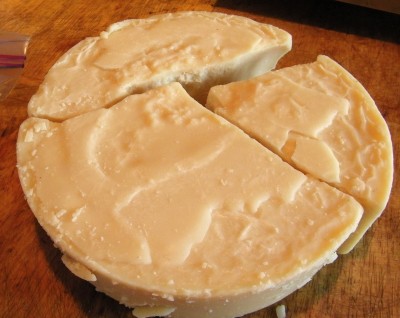
A cake of sheep’s tallow from the freezer
Next I scooped in the coconut oil (soft but still solid in this weather) and then poured the appropriate amount of olive oil. I always try to use the pure olive oil in soap-making. Additionally, don’t worry about melting the coconut oil. We will melt all the oils down together in the next step.
Adding the coconut oil and olive oil to the kettle.
Finally, I took the pre-measured cream out of the fridge, added it to the oils, and put the pot on a low flame.
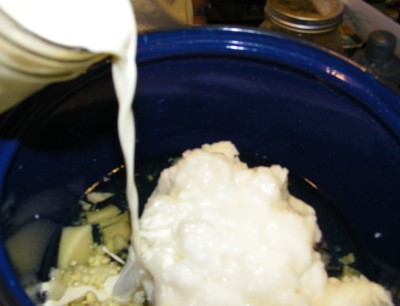 Adding the heavy cream to the oils.
Adding the heavy cream to the oils.
Your cream will want to separate and sit on the bottom of the pot once the other oils melt, so you want to avoid heating too quickly, scorching the cream. Make sure you stir well. Be sure to get all the cream residue off of the bottom and into your soap. When the tallow is almost all melted, shut off the heat, letting the surrounding oils melt it. When it starts saponifying, the tallow will generate a good deal of heat, so you don’t want to start with the oils too warm. 
Heat the oils carefully until nearly melted
For the same reason, don’t worry too much about getting your lye to the exact right temperature. For the most part, getting it to react quickly enough isn’t going to be a problem. The tricky part is making sure your ducks are in a row in case it reacts too quickly.
Lightly grease your mold (olive oil is fine) and set it somewhere convenient. I used a small plastic bin that comes with a snap-on lid. You want the plastic to stand up to the heat of the reaction but be a little bit flexible for good mold-release. (You can also use a sturdy silicone mold from Bramble Berry and add sodium lactate to your lye water, which will also help the soap release faster from the mold.) We make our own front-loader laundry soap, so if I do get ash, I scrape it off and we use it in the batch for the laundry. 
Chopping up two bars of cured brown soap to use as embeds
At this point, I also chopped up my bars of leftover soap into little squares and put the annatto seeds into the coffee grinder. Grind to a fine powder and set aside. I put about half of the leftover soap chunks in the bottom of the greased mold and left the rest handy nearby. (You can also infuse annatto seeds into a lightweight liquid oil, such as sunflower or sweet almond an then use that as the colorant. For more on infusing oils, see this blog post.)

Grinding annatto seed to use as a colorant.

A layer of leftover soap embeds on the bottom of the mold
Now we are ready for the main event. I usually get a second person for mixing the lye into the oils. For one thing, it is easier to mix well when one person pours and the other stirs. In any case, use gloves and eye protection. Have water and rags handy for dealing with any spills, and put the cat outside.

Slowly stir the lye into the melted oils and continue stirring until trace
Stir the stream of lye steadily into your oils. When the lye is gone, set the bottle carefully aside and keep stirring. You won’t be doing this long; stirring with a wooden spoon, it took about ten or twelve minutes to trace (you can also use a stick blender and pulse it in short, 5 – 10 second bursts). A pure-tallow recipe will trace quickly. 
Once it hits trace, the soap will thicken very quickly; you won’t be able to miss it
Set your soap kettle next to your mold. I used a stainless-steel ladle to move about half of the soap batter into the mold to make it easier to pour. Then tap the side of the mold a few times to release trapped air around the embeds. You could just pour from the kettle, but I don’t like dripping lye down the side of the kettle before I am ready to set it safely in the sink.
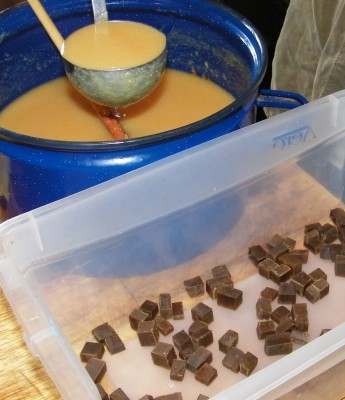
Start ladling soap from kettle into the mold
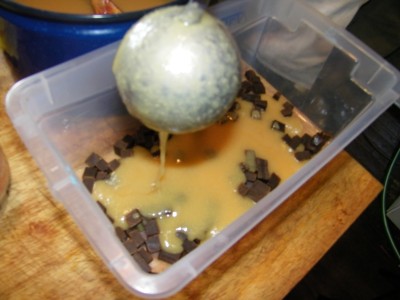

Thoroughly mix the ground annatto seed into the soap batter
Once the annatto is mixed, I poured the colored batch into the uncolored soap already in the mold. I just poured it in — I made no effort to mix it. At this point, even just a minute or two after trace, the soap thickens quite quickly and the colored batch will not mix unless you force it. It is therefore possible to get very controlled results, especially if you want to use a piping bag and icing tips.
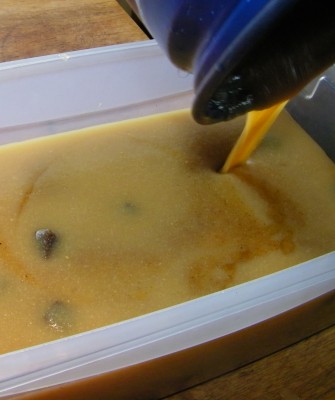
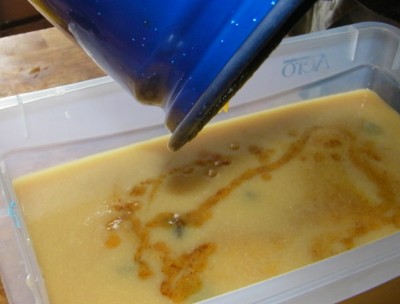
Pour the annatto-colored soap into the mold with the non-colored soap
Lastly, I add the remaining soap embeds on top of the soap. As you can see from the photo, the pre-made cubes sit right on the surface of the thickening soap. Poke them in with your spoon. This means you have complete control over where the embeds sit in your soap, especially if you alternate embeds in layers with multiple pours. The soap will have a yellow color to it at this point, and it may look like there will not be much contrast between the colored and uncolored batches. Don’t worry. 
Add the top layer of embeds and poke them down with the spoon if necessary
Put the lid on your mold (covering with plastic or waxed paper if you like), and set aside somewhere safe. The tallow will generate plenty of heat, so unless you are doing this in the winter or a cold part of the house, you don’t need to worry about insulating; just set the mold aside. Wait patiently.
By morning, the mold was still quite warm. Twenty-four hours after trace, pop the lid off. The curing soap will have whitened up markedly, the annatto-dyed parts will stand out, and the dark soap embeds will offer high contrast. Depending on how much cream got cooked, either by the lye or during melting, you might have a little tanning. Doing this deliberately would make the soap embeds look a lot like chocolate chunks in cookie dough or brownies. 
Pop the lid off of the now set-up soap
To unmold, flip over your mold and flex the sides to get an air bubble started. The loaf should pull away with just a little bit of work (did you remember to oil the mold)? Recipes with a decent proportion of tallow or stearic acid do not tend to stick. I let the loaf sit on brown paper for twenty minutes to let the back dry up just a touch and then cut with a chef’s knife. Twenty-four hours in, the loaf was firm enough to slice. 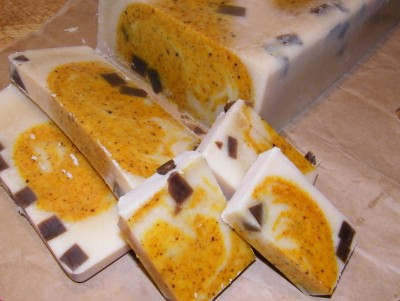
Cut the loaf into sections and then into bars. With a sharp knife, the embeds should slice cleanly
Stack or rack your bars to cure and dry for 4 – 6 weeks, but do not let this recipe sit longer than 24-36 hours before slicing. It will harden quickly and may become brittle: great for laundry flakes or rebatch, but not for cutting nice neat bars. Because this recipe is flexible with its setup and temperatures, you have a lot of design options: you can do longer, thinner embed ‘canes’, slice them, and then put them exactly where you want them.
I like playing with all-vegetable recipes and trying to get the ideal combination, but I love working with tallow and I keep coming back to it. Do you soap with tallow? What do you love about soaping with tallow?

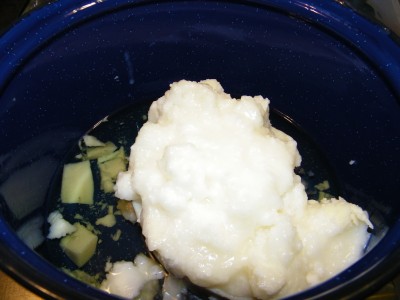

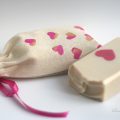
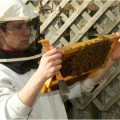

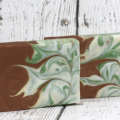
I’ve been experimenting a lot recently and just tried soap from beef tallow I rendered myself, although I sort of cheated. I browned a lot of ground beef and used that fat and boiled it. It, too resulted in a nice, white, hard tallow. I broke some golden rules with this small batch (4 muffin sized bars). I made 100% tallow soap to see about this “creamy” lather and it really is. Another golden rule is I used it two days after unmolding it. It is very hard and it passed the “tongue zap” test with flying colors so I washed my hair with it. The verdict? Squeaky clean and soft. It produced a great lather, but took a lot of rubbing on my head. I also used Wilton’s food coloring to color it and it held it’s vivid color beautifully. Would I do it again? Perhaps if I had a lot of fat at one time and I would use it in the laundry or to wash the car. I prefer my tried and true recipe in the shower, but this was a lot of fun and soaping is my hobby, not my business.
That’s awesome, I’m glad those bars turned out well! The creamy lather is definitely true. I didn’t think I would be a fan of tallow soap but the lather is so fantastic. Thanks for your tips Eric. 🙂
-Kelsey with Bramble Berry
I’m just a fairly new soaper. I just wanted to thank you for the tip on annato seed. Your soap is beautiful. I don’t want to use phoney dyes in my soap.
Isn’t that annatto seed pretty? I like it as well! Also, we have some great natural colorant options you may like. Learn more about those here: http://www.soapqueen.com/bramble-berry-news/sunday-night-spotlight-natural-colorants/
-Kelsey with Bramble Berry
Can the soap be used to wash wool, and other gentle fabrics effectively and safely?
Thanks
Hi Ally!
We didn’t try this recipe on wool, so I’m not exactly sure! Several factors determine whether the wool can be hand washed or dry cleaned. You may want to check out some wool washing resources online before trying this soap on your clothing. 🙂
-Kelsey with Bramble Berry
What would be the benefit of adding cream to a laundry soap? Or is this a laundry soap? I see Eric says “The heavy cream will be counted as half the liquid and will make the superfat cushion, as well as make the soap nicer on the hands”. Either way, pretty pretty white soap!!
Thanks,
Molly
Hi Molly!
Tallow is incredibly versatile, and while we have not tried this particular recipe, this soap could be used on the hands and body as well. Once this soap has been made, it can then be used for laundry flakes or rebatch, but the cream helps it feel wonderful on the skin as well 🙂
-Amanda with Bramble Berry
This is so pretty, do you really use this for laundry soap?
Hi Amy!
While we have not tried this particular recipe, I would imagine that this soap would also be suitable for the hands and body 🙂
-Amanda with Bramble Berry
It could be used as laundry soap, but that isn’t why I used this particular mix. Without specific testing and meticulous measurement, it is hard to tell exactly how much fat is in the cream. So, I start with the same values I would for laundry soap (no extra fats) and *then add the cream* which I know will add a little bit more oils but can’t measure exactly how much.
If I guessed at the fats in the cream and tried to account for it in the recipe, I might be wrong (fat content in cream changes season to season and even milking to milking). If I was too low, the soap would be harsh from excess lye. If I started with a recipe that had superfat and was wrong on the cream, then the soap would be greasy. This way, I know the soap is safe and won’t be greasy.
Does that make sense?
As a general rule, account for the ingredients you know first, then your unknowns won’t bite you.